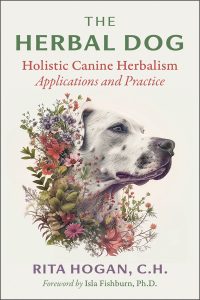A Dog’s Prayer
I pray you who own me, let me continue to live close to Nature.
Know that: I love to run beneath the sun, the moon, and the stars;
I need to feel the storm winds around me and the touch of rain, hail, sleet, and snow;
I need to splash in streams and brooks and to swim in ponds, lakes, and rivers; I need to be allowed to retain my kinship with Nature.Juliette de Bairacli Levy,
The Complete Herbal Handbook for Farm and Stable
“When I was growing up in rural Michigan in the early 1970s, I spent most of my time outside with my best friend, Cathy, on my horse or hanging out with my dog Susie. We would play in the water of the roadside stream, hang from the trees in the apple orchard, and explore the pine woods.
When I was around seven or eight, I saw my first lady’s slipper (Cypripedium arietinum). It was magical. I sat there gazing at it like it was a faerie. Though I wanted to pick it for my mother, she had taught me that lady slippers were rare and had a bigger purpose than her love for beautiful flowers.
My maternal grandmother was an ‘unknowing’ herbalist. She never considered herself a healer; herbalism was simply a way of life for low-income families. She raised 16 children during the Great Depression with only a midwife to help with childbirth. I love my mother’s stories of my grandmother going into the woods with her basket and returning hours later with a bounty of food and medicine.
In the time of my childhood, ‘country folk’ knew the plants around them – which ones to avoid, which ones to eat, and which ones to use for medicine. My father introduced me to plants by gardening and by caring for our cows, chickens, horses, and pigs. Describing them by color and shape, he would tell me to go out into the field, pick a particular plant, and bring it back to him. My dad loved his garden and grew beautiful vegetables without pesticides or herbicides, using the principles of companion planting. I would kneel beside him, asking if every plant was a weed and if I could pick it.
We had many dogs growing up, but the one I remember best is Susie. She was a shepherd-collie mix. My dad loved her and ensured she was well cared for. Susie was intact (unspayed) and only minimally vaccinated, and she ate a varied diet of raw milk, butter, eggs, and table and meat scraps, including organ meat. She would nibble on grass, berries, apple peels, and self-selected plants. I know this sounds fancy now, a raw-food proponent’s dream, but back then it was just how you fed your dog when you lived in the country.
Susie loved the outdoors like I did; she stayed outside except when it was raining or cold. My dad let her choose at night, leaving the garage door ajar so she could sleep inside if she wanted. Susie died when she was 24. That is a long time to live, for a dog, and in my memory it wasn’t all that uncommon back then. My adult self wishes I had paid more attention to the details of her upbringing, but I was a busy kid and didn’t know that I would be knee-deep in the all-natural dog world when I grew up.
Eventually I left home and settled in Minneapolis, Minnesota, where I embraced my 20s and expanded my consciousness. In college, I studied Eastern religions, anthropology, feminism, and an Eastern herbal medicine practice called ayurveda. My favorite book on the subject was A Life of Balance by Maya Tiwari. I loved how ayurveda looked at the body as an individual, and instead of seeking outside yourself for answers, you were taught to look within. This started me on the path of introspection, learning about the importance of diet and working on my emotional and spiritual self. Eventually, I fell in love, got my first pug, and reluctantly moved south.
My partner and I bought a 32-acre hilly parcel in the unincorporated town of Elmwood, Tennessee, about an hour east of Nashville, at the end of a dead-end road. What I loved about our ‘farm’ was that it was mostly a deciduous forest where the dogs and I could walk around, sit in silence, and commune with the flora and fauna, which included beech, elm, and many of the plant friends I learned about when I was young.
In my late 20s, I realized that I didn’t want to pursue Eastern medicine even though I loved it; I missed the plants I had grown up with. Our new farm helped me reconnect to the land and my love for animals. We decided to board dogs for a living and opened Almost Home Pet Farm, a kennel-free boarding facility on five acres surrounding our home. I started noticing straight away the declining health of the dogs we boarded and making the connection to their poor diet of cheap kibble and pills. Luckily, I befriended a brilliant woman who owned an all-natural dog food store in the city. She helped educate me on alternative diets for dogs, the kibble hierarchy, raw food, home-cooked food, and healthy treats.
After finding out about the excellent dog food options available in the Nashville area (where most of our clients came from), I implemented a dietary requirement for dogs that wanted to board with me. This included a pre-boarding interview where I would ask potential clients what types of food they were feeding their dog, gently educate them on the power of a better diet, and then give them a list of acceptable foods. Then I would send them to my friend’s store to get food from my list. This might sound drastic, but it resulted in calmer, healthier dogs. It wasn’t long before clients were calling me to tell me how improved their dogs were after just a few months of their new diet.
During the early years of Almost Home Pet Farm, a friend and I started a holistic pug rescue organization called Music City Pug Rescue. We were one of the first holistic dog rescues in the country, and we found homes for hundreds of pugs over six years. Doing this type of work taught me so much about dog behavior, the roots of disease, the importance of the nervous system, and the pitfalls of allopathic veterinary care.
Blending rescue and kennel-free boarding was a blessing that allowed me to study herbalism and work with sick dogs and clients desperate for answers. I started putting health puzzles together and seeing the difference diet and herbs could make. Behind the scenes, I started making my own herbal medicines and founded a company called Farm Dog Naturals to sell them.
Around 2005, The Complete Herbal Handbook for the Dog and Cat by Juliette de Bairacli Levy found me. Juliette was an English herbalist, skilled animal herbalist, and pioneer of holistic medicine. Reading her book was one of the many transformational moments that guided me toward my practice as a canine herbalist. I learned that I wasn’t alone in my thinking. Juliette’s bravery in speaking her truth for the world to hear filled me with joy, giving me hope and courage for my own experience.
I began looking for other dog-related health books. I immediately noticed that the idea of individualized care was missing from the field, and plant language was obsolete. I pivoted and focused on herbalism and the plants I knew and loved. Up until this point, the herbalism books I read were general. They taught me to make tinctures, salves, oils, poultices, and infusions. I appreciated the guidance, but something was missing.
One morning, I visited Rhino Used Books in Nashville and found herbalist Matthew Wood’s first book, Seven Herbs: Plants as Teachers. I had doubted my use of drop dosing with dogs because I kept seeing that books and herbal product labels recommended using large amounts of tinctures. I believed in letting the body speak for itself if higher dosages were warranted. Matthew talked about using “spirit dosages,” or very low dosages of a tincture, to stimulate the body to heal itself and, in essence, using plant intelligence. For the first time, I felt validated on my plant path.
Shortly after, a second book, veterinarian Cheryl Swartz’s book Four Paws, Five Directions, found me. She introduced me to the diagnostic principles of traditional Chinese medicine for dogs and the concept of the body as a connected ecosystem. I knew I didn’t want to study Chinese herbs, but I used what I learned and applied those principles to Western herbology.”

The Herbal Dog by Rita Hogan, C.H. published by Inner Traditions International and Bear & Company, © 2025. All rights reserved. http://www.Innertraditions.com Reprinted with permission of publisher.
A Hands-On Guide to Holistic Canine Herbalism
In this comprehensive guide to holistic care for dogs, clinical canine herbalist Rita Hogan explains that, by looking at dogs as individual ecosystems with their unique personalities, physiology and needs, we can select effective and personalised herbal remedies to support their constitutions and provide relief from many different ailments.
Ms Hogan, who has spent more than two decades working with canines, uses energetic principles (cool, warm, dry, damp) to reveal how herbs are not ‘one size fits all’ and to explain how to choose herbs and herbal combinations for dogs as individuals. She moves you, step-by-step, through the tenets of holistic canine herbalism, including exploring how to find the root cause of chronic imbalances. She discusses in depth how a dog’s main organ systems work, how they are connected to each other and why we need to understand them when choosing specific herbs and foods.
Presenting safe, clinically proven and effective protocols for common canine conditions, from acid reflux to allergies, to itching, scratching and yeast, Ms Hogan explores a wide variety of holistic and herbal remedies, from herbal tinctures, glycerites and phytoembryonics to flower essences, essential oils, medicinal mushrooms and homeopathy. She provides readers detailed options and guidance according to their dog’s energetics.
Sharing a comprehensive materia medica of canine-specific herbs used in her practice, she explains what herbs are good for which conditions and why, what types of energetics are involved, safe dosage recommendations for each herbal remedy and when to discontinue a herb.
Allowing each of us to take a hands-on approach to our canine companions’ health and longevity, this herbal guide outlines how to heal them and support them as the individuals they are and help them live their best lives by our sides.



